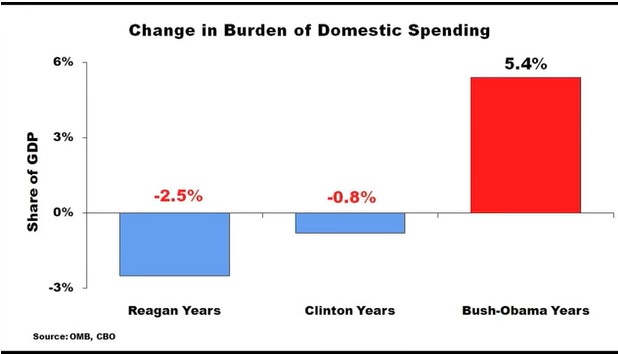More than 10 years ago, I narrated this video showing how the United States benefited from spending restraint under both Ronald Reagan and Bill Clinton. Since today’s topic is Clinton’s policies, pay attention starting about 4:00.
If you don’t have time to watch the video, I hope you will at least pay attention to this chart, which appeared near the end (about 6:00).
It shows what happened to domestic spending (entitlements plus discretionary) as a share of economic output during the Reagan years, the Clinton years, and the 2001-2010 period under Bush and Obama.
Reagan was the runaway champion, but it’s worth noting that the burden of domestic spending also declined during the Clinton years.
But it wasn’t just that Bill Clinton was good on spending. Good things happened in the 1990s in other areas as well, especially trade.
In a column for the Wall Street Journal, Bill Galston defends Clinton’s “neoliberal” record.
… critics often mark the Clinton administration as the moment when establishment Democrats capitulated to the ideology of the unfettered market. Poor and working-class Americans paid the price, they charge… The historical record tells a different story. …During eight years of the Clinton administration, annual real growth in gross domestic product averaged a robust 3.8% while inflation was restrained, averaging 2.6%. Payrolls increased by 22.9 million… Unemployment fell from 7.3% in January 1993 to…4.2% at the end of President Clinton’s second term. Adjusted for inflation, real median household income rose by 13.9%. …During the administration, federal spending as a share of GDP fell from 21.2% to 17.5%… What about the poor? The poverty rate declined during the Clinton administration by nearly one quarter, from 15.1% to 11.3%, near its historic low. And it declined even faster among minorities—by 8.1 percentage points for Hispanics and 10.9 points for blacks. …In sum, during the heyday of neoliberalism, Americans weren’t forced to choose between high growth and low inflation or between aggregate growth and fairness for the poor, working class and minorities.
Why did we get these good results?
Because overall economic freedom increased during the Clinton years. And when the burden of government is reduced, that creates more opportunity for upward advancement for everyone in society.
By the way, I’m not arguing in today’s column that Bill Clinton deserves all the credit. There’s little doubt that the Republican landslide in 1994 played a big role in many of the subsequent pro-market reforms (such as welfare reform, the 1997 tax cut, etc).
But I will say that Bill Clinton at least was amenable to pro-market compromises, which is not what we saw during the Obama years (and I doubt we will see a shift to the center from Biden if Republicans win Congress this November).
P.S. Republicans were able to impose some fiscal discipline on Obama after the Tea Party landslide of 2010
P.P.S. For those who want more details, click here for a detailed examination of the fiscal policy performance of various modern presidents.
———
Image credit: The U.S. National Archives | Public Domain.




